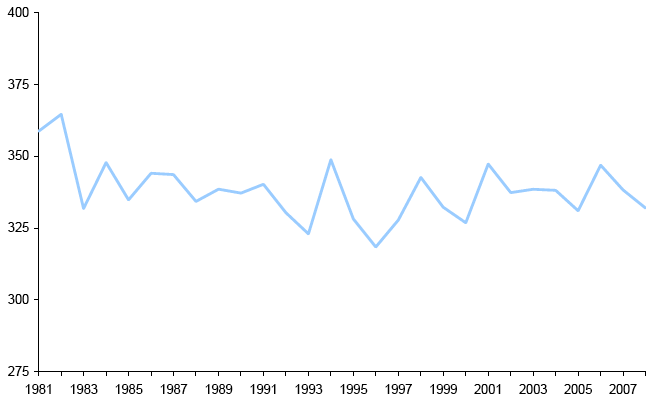Key Scottish Environment Statistics 2009
Annual publication containing summary of key statistics on environmental trends in Scotland
Global Atmosphere
Column Ozone Measurements R: 1981-2008
Column ozone concentrations over Lerwick (Dobson units)

Column ozone concentrations (Dobson units)
Station |
1981 |
1985 |
1990 |
1995 |
2000 |
2005 |
2006 |
2007 |
2008 |
|---|---|---|---|---|---|---|---|---|---|
Lerwick |
358.7 |
334.8 |
337.2 |
328.2 |
326.9 |
331.0 |
346.9 |
338.3 |
332.0 |
The stratospheric ozone layer, located around 10-30 km above the Earth's surface, forms a protective shield against harmful solar ( UVB) radiation. 18 Thinning of the ozone layer has occurred since the beginning of the 1980s in all regions except equatorial ones. Depletion is most marked in the Antarctic where, in 2006, the Antarctic ozone hole reached 29.5 million square kilometres in area (over 300 times the land area of Scotland). 19
The 1987 Montreal Protocol set guidelines to eliminate the global production and use of ODS. European production of CFCs for non-essential use fell to zero in 1995. 19 However, leaks from old equipment and the long life of these substances in the lower atmosphere mean that full recovery of the ozone layer is not predicted until about 2050.
Over the last 26 years, the annual average total ozone cover over Lerwick has shown the natural interannual variability which would be expected due to varying meteorological conditions, but generally levels have decreased over this period. Record levels of chemical ozone depletion were reported at Lerwick in March 2005. This has been attributed to local meteorological conditions and the passage of Arctic lower stratospheric air in which ozone had been depleted.
Source: AEA Energy and Environment
There is a problem
Thanks for your feedback